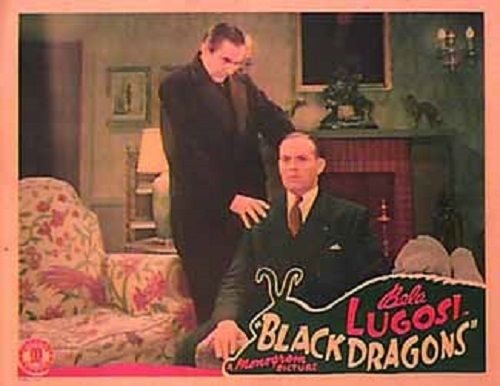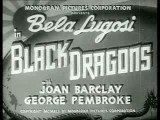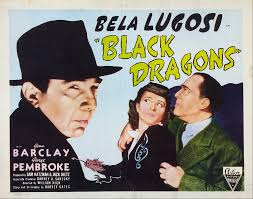Black Dragons (1942)
IMDb meta-data is 1 hour and 4 minutes, rated 4.3/10.0 by 907 cinematizens
Genre: Confusion.
Verdict: Monogram quality. (Say no more.)
The set-up: a room full of portly American men with svelte molls congratulate themselves as the war rages. Strangely they are celebrating, strikes, slowdowns, sabotage, arson, and destruction of their factories, rolling stock, warehouses, and ships. Though they look like the usual cast of B-movie extras they are no patriots! Are they Republicans? They are traitors!
Into their midst intrudes Bela Lugosi to whom no one ever says no. With the help of an ever handy hypodermic, he manipulates the host. Thereafter the industrialists play ten little Indians as one after another is found dead on the doorstep of the Japanese embassy in Washington DC. How they died and got delivered C.O.D. is left off stage. Perhaps Lugosi has a bulk contract with USPS for corpse deliveries. After the second or third, foul play is suspected.

As always Lugosi appears and disappears by script magic. He sneaks up behind each victim and….
As the pile of corpses on the Japanese embassy doormat mounts the Lone Ranger, constantly flipping open his wallet looking for his mask, appears to investigate – the host’s niece. Nice.
SPOILER. In the last few minutes we discover that the industrialists had all been replaced by doppelgängers made to order by plastic surgery, the miserable scriptwriters crutch. The substitutes are nefarious Japanese who talk just like Ohio but are members of the dreaded Black Dragon Society. Where all those molls who were likewise celebrating American setbacks came from is left to the viewer’s imagination.
The surgeon who altered the men was …. [Go on, guess] the dedicated Nazi doctor Lugosi. Ah ha. To show their gratitude the Black Dragons threw Lugosi into a prison cell, so that he would not blow the cover of the agents he had created. Sounds like McKinsey management at its best: Save on the surgeon’s fees.
Black Dragons may be mean but smart they are not. Of all the prison cells in all the worlds, they put him in one with an exact look-alike due to be released. With a flick of his cape, Lugosi swaps with the look-alike and goes free to seek his revenge by travelling as a Nazi from Japan to the USA during the war. Sure. Why not. Book that berth and sail away across the Pacific, Manila, Guam, Wake, Honolulu all the way.
Moreover, this dedicated Nazi’s revenge helps the American war effort. Sure that adds up.
The substitution explains why a saboteur can have a nice niece. It does not explain why she does not notice any difference in her favourite uncle. (The script gives her some outs but they are lame, to say the least.) Still less does it explain why anyone would care.
It was released on 6 March 1942. The opening credits feature a rising sun flag in the frame.

The film would have been made in a fortnight in early February just after the Japanese sneak attack on Pearl Harbor, when the threat of other attacks or even an invasion was in the air.
Insightful observations follow. Buckle up. Everyone smokes. Everyone. That surprised me because I thought smoking became general after World War II, because the mass production of cigarettes for the Army spread the habit and made it cheap. But in the opening scene at the dinner party the air is thick with smoke and every actor has a cigarette, pipe, or cigar. Now, perhaps in that scene the smokes are being used to indicate how rich and decadent they are, but that seems far too subtle for anything from a Monogram production, though the smoking is less distracting thereafter.

